Koi farms in Japan
September 2024

I have to confess that I don't really know much about koi at all. This makes developing a koi breeding game somewhat difficult. That's why I've made a trip to the area in Japan where most of the world's best koi are from. I assumed koi farms were distributed all over Japan, but in reality that's not the case: many of the best koi farmers are all located in the same area, in the mountains east of the small village of Ojiya. In fact there are so many koi farms there you can see it from space, the mountains are filled with hundreds of mud ponds where koi live during the summer.
We travelled to Japan together with our audio designer who brought recording equipment with him to capture authentic ambient sound, and got in touch with koi exporter Japan Koi Service, whose owner was kind enough to give us a tour of the area. He has good personal relationships with many of the great koi breeders in the area, so we were able to get a rare look behind the scenes.
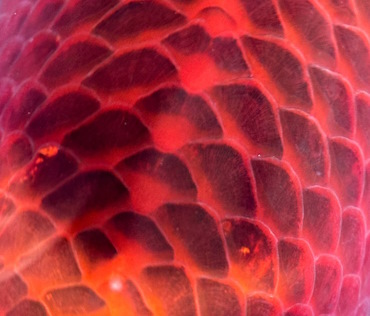
I was able to take a very close look at some koi, studied their patterns and they way they interact with scales, and I've learnt about the many possible variations that exist. Koi breeders don't just select for patterns, colors and scale quality, but there are also different ways in which the pattern shows up on the scale; sometimes pigments are stronger on th edge of a scale, sometimes it's the other way around. The interaction of pigments and scales can be really beautiful.
The fins however don't seem to vary that much, and apart from health and quality, it doesn't seem like they are very important to breeders. The overall shape seemed to be much more important to them. Smooth cigar-like shapes are preferred, although some of the bigger koi we saw had a noticeable disconnect between the head shape and the body shape which was preferred by some customers.
Most koi raised in Ojiya don't stay in Japan, they are instead exported all over the world. It was surprisingly difficult to find Koi in Japan! Customers in different parts of the world also prefer different types of koi. Europeans for example like koi in their gardens but won't usually buy the very expensive ones, while people who join koi shows and competitions invest large sums of money to find the best prize winning koi out there. Most Japanese people don't have very big gardens that would fit a koi pond, so apart from some public places and museum gardens, there weren't many koi around. I've heard about famous places where koi live in the canals, which we unfortunately weren't able to visit.

I didn't really know what separated common koi from rare sought after koi, but when I was shown a famous breed of Kohaku, I could immediately tell these were special. They were bigger, the colors were more vibrant, the scales were beautiful and they clearly stood out from the rest. These koi are very expensive and aren't kept in the mud ponds outside, they stay indoors all year round until they are sold. Before entering this particular farm, we had to disinfect our shoes and hands just to make sure we didn't transmit anything to the koi. Seeing the difference between very expensive and very common koi wil really help me design the game in such a way that players are rewarded for breeding the most beautiful koi. After all, it's not just a matter of personal taste, some properties are recognized by every koi breeder.
I studied and recorded koi behavior as well. Animating all subtle motions of swimming fish is difficult, especially the motion of their fins can be puzzling. What I also noticed clearly is that koi aim their eyes at the things they want to look at (not all fish do!). This is great, because animating koi eyes will allow me to give them a lot of character that would be hard to replicate without eyes or other ways to show some kind of emotion or intent.
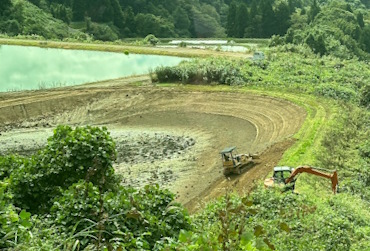
To my surprise, the shape that ponds in Koi Farm 2 currently have are very similar to the shape of the real mud ponds. The only difference is that real mud ponds tend to be much deeper. The big ones are easily four meters deep, and as the name suggests, they are muddy and opaque. Koi love this, but you won't be able to see them until the moment they are taken out and brought back to the koi farms where they stay during the winter, if they aren't sold.
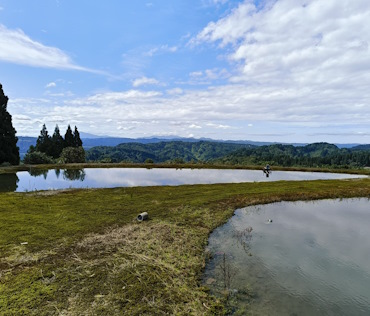
The mud ponds are largely unattended during the summer, and some can only be reached by driving over rough mountain roads. The 2004 earthquakes in the region have destroyed a lot of infrastructure, and some damage can still be seen. Koi grow very well in these outdoor ponds, and while they feed off the bottom they are also fed by automatic feeding machines. These are solar-powered and dispense food pallets every few hours. Unfortunately, the bears in the area also love koi food, so breeders need to be creative to prevent them from stealing the food, and worse, destroying the feeding machines to get to it.
Some larger bird species can also be a problem because they see koi as possible snacks. While the big koi are often way too heavy for them to eat or even pick up, birds do sometimes damage their scales by picking at them. There really isn't a great solution for this since the area is so large. Ponds with small fish are protected by nets, and the most expensive koi are simply kept indoors to protect them from attacks, although they don't grow as well if they don't live in the mud ponds.
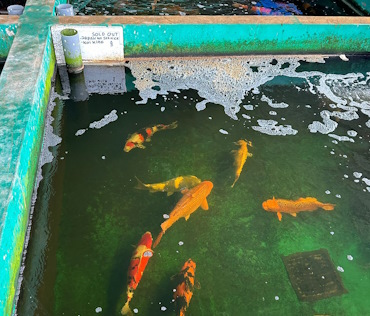
The "koi farm" in my game looks nothing like a koi farm. In reality, the koi farms themselves are greenhouses with simple concrete ponds with clear water. While they are close to the outdoor mud ponds, koi are bred and sold indoors. Koi Farm 2 will not have indoor concrete ponds, it's not a very inspiring or relaxing environment, so I'll have to depart from realism here. Players will only be able to make outdoor ponds, but with clear water instead of mud, since koi would never be visible if these ponds looked like real mud ponds.
All ambient sound has been recorded outside as well, since the indoor koi farm pond audio isn't all that inspiring. We have recorded audio in several locations without unnatural background noise, like the mountains east of Nara. Most recordings feature little streams and many different Japanese bird species can be heard in the background.
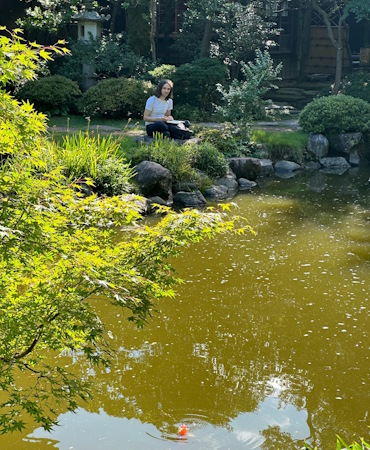
Another thing I noticed is that my beloved butterflies in Koi Farm 1 weren't all that realistic. Instead of butterflies, the ponds are surrounded by huge dragonflies. I've never seen so many dragonflies anywhere, so it seems like the ponds provide a very attractive habitat for them.
While the Koi Farm 1 ponds are surrounded by tall grass, that doesn't seem to be usual in Japan. Moss dominates the shore, with patches of reed and shrubbery growing further away from the water.
The environment in Koi Farm 2 will look like a mix between the outdoor mud ponds and a traditional Japanese garden. The water will be clear instead of muddy, for obvious reasons, and the atmosphere will be peaceful and relaxing. If I do a good job, it will remind me of the beautiful environment of the mountains east of Ojiya. I want to capture as much of the authentic koi farming spirit as possible.
In conclusion this was a very interesting, fun and productive trip! It will help me make Koi Farm 2 the best and most authentic game it can be.